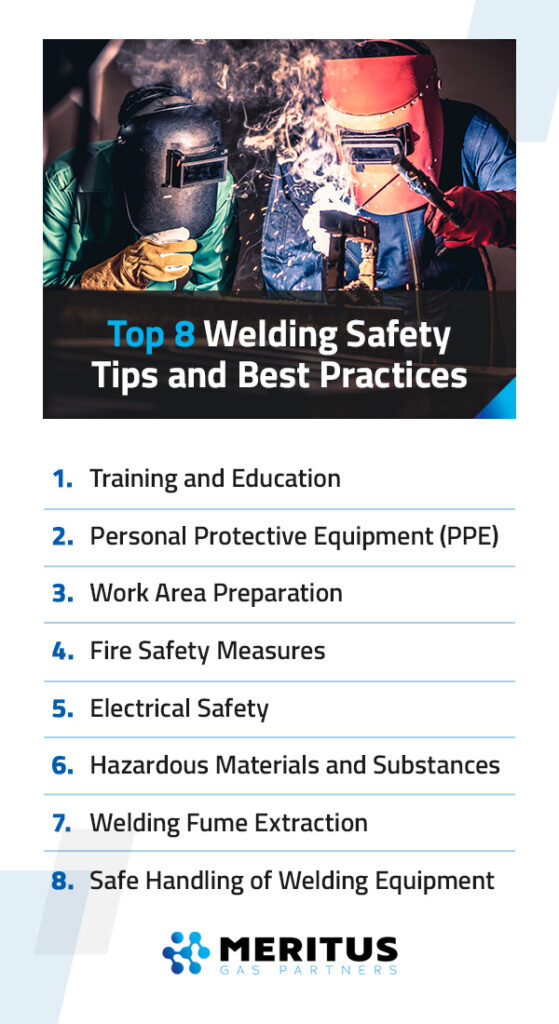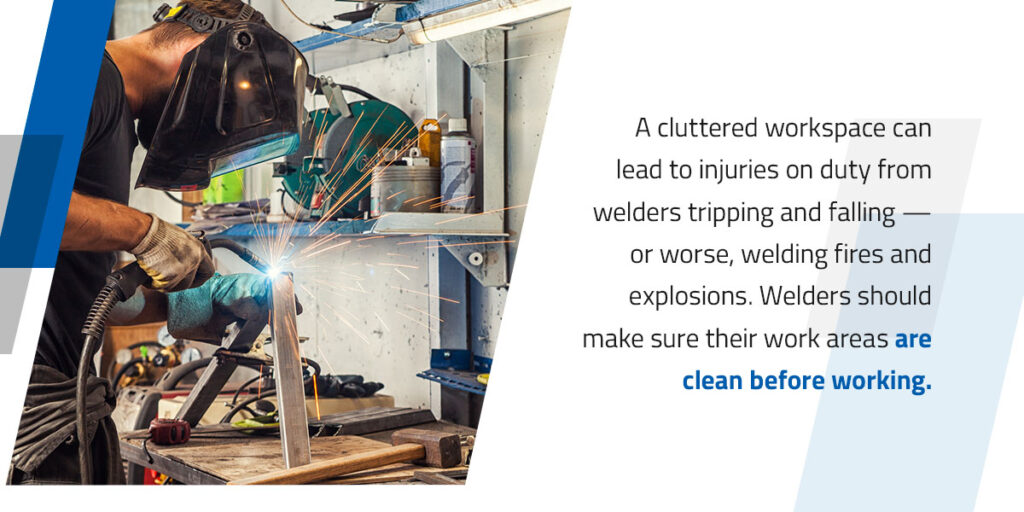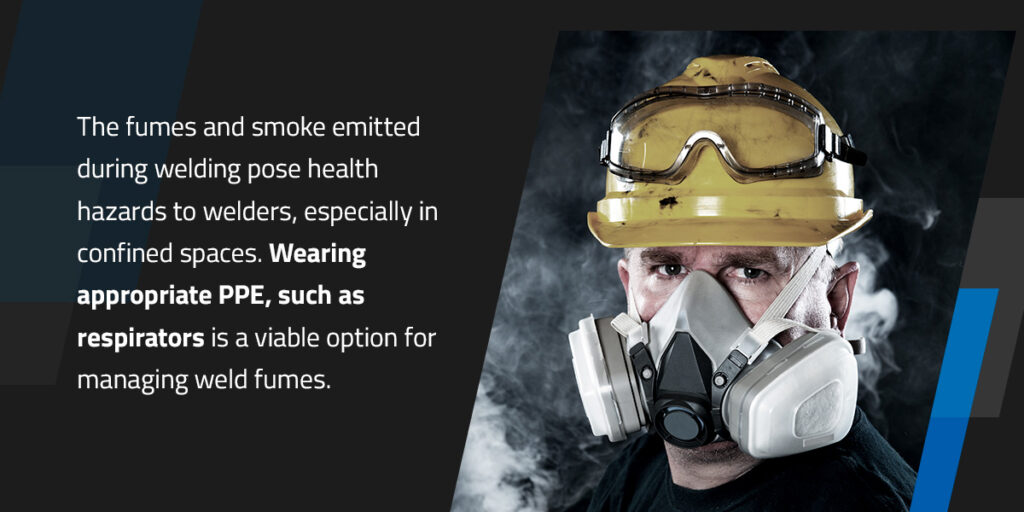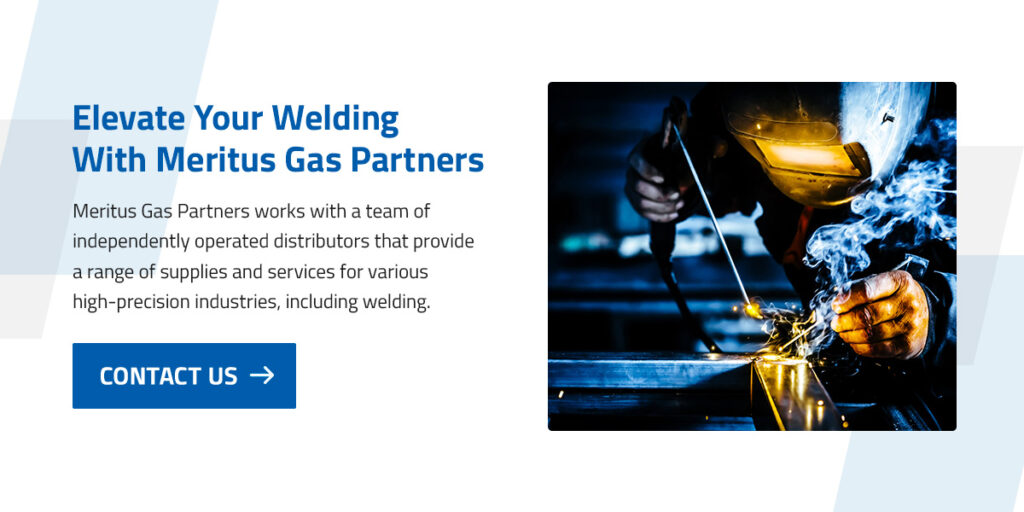

Anyone involved in welding practices, whether a small independent fabricator or someone who works for a welding-intensive company, must know fundamental welding safety tips. In general, it’s essential to use safety equipment for welding, abide by OSHA welding safety regulations and purchase equipment and supplies from reputable gas and welding manufacturing brands to ensure a healthy and safe work environment for welders.
Below are eight safety tips for welding that will help equip welders with best practices to avoid hazards and establish safer workspaces.
According to OSHA, welders are at risk of various safety hazards while on the job. The American Welding Society also maintains a comprehensive fact sheet detailing welding health and safety concerns. Thankfully, most of these concerns are entirely avoidable or require standard safety protocols to mitigate potential danger.
By fostering welding best practices, such as supplying and ensuring welders wear safety equipment for welding, employers can help protect welders from the five most common welding safety hazards:
OSHA document 29 CFR 1910 Subpart Q breaks down OSHA welding safety and procedural requirements, including various topics that pertain to welding best practices. Furthermore, the American National Standards Institute (ANSI) outlines a spectrum of welding safety standards, including general welding safety standards, arc welding safety standards and more. The level and manner of implementation depend on the type of welding and the company’s context.

Welders should hold themselves and others accountable to uphold health and safety standards and maintain an optimal working environment. The following is a breakdown of the top welding safety tips every welder and welding employer should know and implement.
There is always a need for skilled welders. This is particularly true considering the current welder shortage in the United States. There are various avenues for welders to learn how to weld and acquire positions in multiple industries. Although a person can learn to weld without formal training, obtaining proper certification or accreditation is best before looking for work.
Being properly certified may lead to more and improved job opportunities. Further, education, which is part of certification, helps welders stay updated on safety regulations and best practices. This means engaging in ongoing learning programs that offer refreshers and insights into the latest safety practices and welding techniques.
Before using unfamiliar or new machinery and equipment, it’s vital to understand the proper procedures. Although laborious, studying the user manuals, warning labels and safety guidelines is a welding best practice. If a welder or their employer feels that further training is needed before using the welding equipment or consumables, that’s a chance to expand workplace knowledge and safety.
What’s the essential safety equipment for welders to avoid injury? In order to help prevent potential physical injuries and diseases, welders should always dress in flame-resistant clothing and other PPE and safety equipment for welding as outlined in OSHA Standard 1910 Subpart I, which discusses all relevant requirements for welding operations.
Types of essential PPE and safety equipment for welding include:

A cluttered workspace can lead to injuries on duty from welders tripping and falling — or worse, welding fires and explosions. Welding sparks can travel several feet, so keeping the workspace free of any potentially flammable substances or materials is vital. Ensure only the necessary tools and equipment are out while everything else is packed away.
Welders should also make sure their work areas are clean before working. This step is crucial and can help prevent welders from slipping, keep equipment and materials cleaner, allow welders to avoid contaminated welds and reduce potential fire hazards.
Additionally, welders should make a practice of taking in their surroundings and identifying all relevant equipment locations and potential hazards. Welding equipment should be adequately secured where possible to avoid accidental movement. Knowing where everything is and what the potential dangers are allows a welder to work more productively, organize the work area better and make safety-related decisions.
Finally, before working, welders should ensure ventilation systems are operating and there is sufficient airflow. It’s also crucial to be aware of any drafts or wind, which can carry sparks further than expected and be a fire hazard.
The welding process produces several heat sources that can easily ignite flammable materials. These heat sources include:
Clearing the work area of any flammable materials is one of the welding best practices. Before beginning work, welders should take inventory of their environments and note the locations of fire protection as outlined in OSHA Standard 1910 Subpart L, which includes:
Another OSHA welding safety component is understanding and following fire emergency procedures, as outlined in OSHA Standard 1910 Subpart E. It’s imperative that welders are aware of and trained in the company or premises’ emergency procedures before welding work commences.
There are two types of electrocution that may occur during welding:
Welders should always take specific measures to alleviate and eliminate all potential electrical risks, including:
The primary hazardous materials and substances that welders store and use are two-part and three-part welding mixtures made up of a combination of gases. If compressed canisters are not managed appropriately, they pose significant risks. Apart from fire and explosion risk, gas cylinders can also become projectiles if mishandled or damaged.
Therefore, companies and welders should safely handle and store flammable gases and liquids. Several detailed requirements and guidelines for hazardous materials are listed in OSHA Standard 1910 Subpart H and are worth consulting. In general, these are some welding safety tips and best practices that are in line with OSHA welding safety:

The fumes and smoke emitted during welding pose health hazards to welders, especially in confined spaces. The type of gases and fumes will vary depending on the type of welding and the materials being used and welded.
When welders are overexposed to various welding gases and potentially harmful fumes, they risk short-term effects, including irritated eyes, nose, and throat, dizziness, and nausea. Serious health problems, including respiratory illnesses, cancer and neurological effects, are also possible.
Thankfully, there are viable options and procedures for managing weld fumes. Some control measures for welding fumes and gases include:
Apart from receiving the appropriate training and being familiar with welding equipment, a welder should also improve their safety by:
Shop Equipment Equipment Repair & Services

By following these welding safety tips and adhering to welding best practices and requirements set by OSHA and other relevant organizations, welders can mitigate risks and maintain safe work areas. Receiving adequate training, wearing PPE, maintaining equipment, executing safety protocols and using premium welding and gas supplies boosts welder safety and confidence.
Meritus Gas Partners works with a team of independently operated distributors that provide a range of supplies and services for various high-precision industries, including welding. To learn how we and our trusted partners can assist you with welding safety, supplies, equipment and more, contact us or visit one of our branches near you.